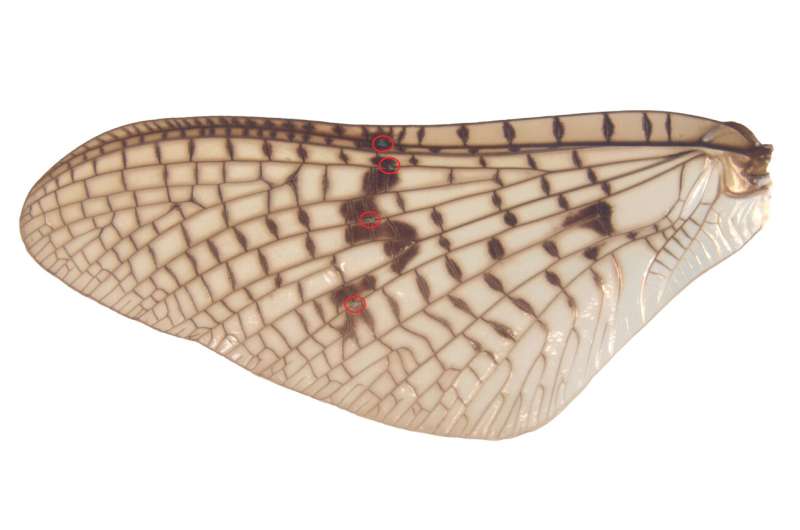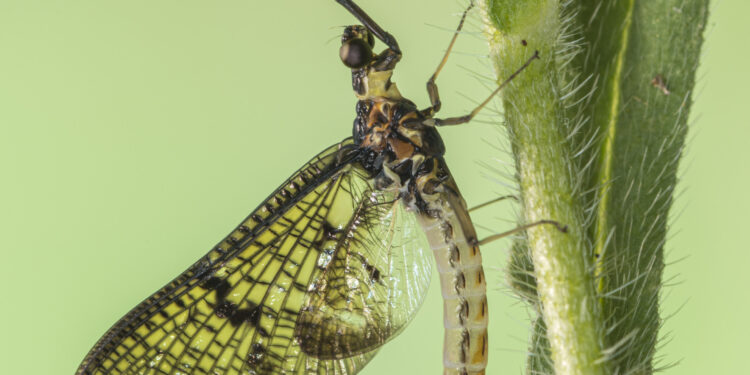Adult Green Drake Mayfly (Ephemera danica). Credit: A. Staniczek
Mayflies are ancient insects that have a unique life stage not found in other winged insects: their fully developed nymphs transform into a winged subadult stage, called subimago, which is not yet capable of reproduce and which, after a short time, loses its skin and its wings to become an adult insect.
An international team led by Dr. Arnold Staniczek, an insect specialist at the Natural History Museum in Stuttgart, used modern technologies to discover and describe a key mechanism in the molting process from subadult to adult.
Some of the wing veins of mayflies include bubble-shaped areas called “bubbles.” The team’s investigations revealed that these bubbles in the mayflies’ wings do not play a role during flight, as previously thought, but are crucial for molting to the final adult stage. The results, published in the journal BMC Biologyalso provide clues to the evolution of winged insects.
Modern technologies help analyze wing structures
For 70 years, it was believed that the bubbles in the wing veins of mayflies played an essential function in the flight of these ancient insects by passively bending the outer part of the wing downward during ascent, thus providing less air resistance and allowing the wing to lift more easily. This theory has now been overturned by authors using modern research methods.
“When we took high-speed videos of mayflies in flight, we quickly realized that the previous theory could not be confirmed: instead of folding the wings when climbing, they are simply held vertically to avoid resistance air, but the wing itself remains stable,” says Dr. Staniczek.
The wing bubbles and their detailed structure were studied by scanning electron microscopy, synchrotron micro-CT and fluorescence microscopy, which confirmed that the bubbles are in fact membrane weak spots in the wings of both winged stages of these insects.
By filming the molt of subadults into adults, the researchers observed that “to tear off the new wings from the rejected skin, the mayflies raise their wings, bending them at defined weak points to extract them more easily and intact. do the same thing by bending the arms to remove a sweater more easily”, explains Staniczek. This hypothesis was also indirectly confirmed by the observation of the absence of bubbles in the few mayflies which lost the subimaginal molt during of evolution.

Forewing of the Green Mayfly Drake, with bubbles outlined in red. Credit: SMNS, A. Staniczek
Important clues about the evolution of insect flight
The bubbles thus constitute a reliable marker of subimaginal moult. When subsequently analyzing the fossil mayflies, the researchers were able to observe bubbles in 272 million-year-old fossils from the Permian period, showing that the earliest ancestors of today’s mayflies already used the same molting mechanism for their wings and that it is an ancient molting mechanism. characteristic of these insects.
The bubbles and winged subadult life stage are not found in other extant insects, whereas this intermediate stage may have been preserved in mayflies for selection advantages related to the transition from aquatic larval habits to adult life on earth.
“This work provides new information and a basis for further research into the evolution of flying insects. A further search for bubbles in the fossil record could reveal whether and when other winged insects also had a winged subadult. evolution has been lost.” Staniczek said.
More information:
Eduardo Domínguez et al, The function of wing bubbles in mayflies (Insecta: Ephemeroptera) reveals new insights into the early evolution of Pterygota, BMC Biology (2023). DOI: 10.1186/s12915-023-01750-8
Provided by the State Museum of Natural History Stuttgart
Quote: Characteristics of the wings of primitive insects revealed (November 24, 2023) retrieved on November 24, 2023 from
This document is subject to copyright. Apart from fair use for private study or research purposes, no part may be reproduced without written permission. The content is provided for information only.



